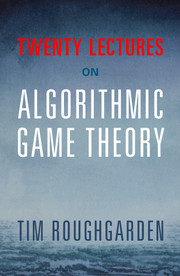Book contents
- Frontmatter
- Dedication
- Contents
- Preface
- 1 Introduction and Examples
- 2 Mechanism Design Basics
- 3 Myerson's Lemma
- 4 Algorithmic Mechanism Design
- 5 Revenue-Maximizing Auctions
- 6 Simple Near-Optimal Auctions
- 7 Multi-Parameter Mechanism Design
- 8 Spectrum Auctions 97
- 9 Mechanism Design with Payment Constraints 113
- 10 Kidney Exchange and Stable Matching
- 11 Selfish Routing and the Price of Anarchy
- 12 Over-Provisioning and Atomic Selfish Routing
- 13 Equilibria: Definitions, Examples, and Existence
- 14 Robust Price-of-Anarchy Bounds in Smooth Games
- 15 Best-Case and Strong Nash Equilibria
- 16 Best-Response Dynamics
- 17 No-Regret Dynamics
- 18 Swap Regret and the Minimax Theorem
- 19 Pure Nash Equilibria and PLS-Completeness
- 20 Mixed Nash Equilibria and PPAD-Completeness
- The Top 10 List
- Hints to Selected Exercises and Problems
- Bibliography
- Index
12 - Over-Provisioning and Atomic Selfish Routing
Published online by Cambridge University Press: 05 August 2016
- Frontmatter
- Dedication
- Contents
- Preface
- 1 Introduction and Examples
- 2 Mechanism Design Basics
- 3 Myerson's Lemma
- 4 Algorithmic Mechanism Design
- 5 Revenue-Maximizing Auctions
- 6 Simple Near-Optimal Auctions
- 7 Multi-Parameter Mechanism Design
- 8 Spectrum Auctions 97
- 9 Mechanism Design with Payment Constraints 113
- 10 Kidney Exchange and Stable Matching
- 11 Selfish Routing and the Price of Anarchy
- 12 Over-Provisioning and Atomic Selfish Routing
- 13 Equilibria: Definitions, Examples, and Existence
- 14 Robust Price-of-Anarchy Bounds in Smooth Games
- 15 Best-Case and Strong Nash Equilibria
- 16 Best-Response Dynamics
- 17 No-Regret Dynamics
- 18 Swap Regret and the Minimax Theorem
- 19 Pure Nash Equilibria and PLS-Completeness
- 20 Mixed Nash Equilibria and PPAD-Completeness
- The Top 10 List
- Hints to Selected Exercises and Problems
- Bibliography
- Index
Summary
Last lecture proved generic tight bounds on the price of anarchy (POA) of selfish routing, parameterized by the edge cost functions. One particular instantiation of these bounds gives a rigorous justification for the common strategy of over-provisioning a communication network to achieve good performance (Section 12.1). A different result in the same vein states that a modest technology upgrade improves network performance more than implementing dictatorial control (Sections 12.2-12.3). Applications in which network users control a non-negligible fraction of the traffic are best modeled via an “atomic” variant of selfish routing (Section 12.4). The POA of atomic selfish routing is larger than in the “nonatomic” model, but remains bounded provided the network cost functions are affine (Sections 12.4-12.5), or more generally “not too nonlinear.”
Case Study: Network Over-Provisioning
Motivation
The study of selfish routing provides insight into many different kinds of networks, including transportation, communication, and electrical networks. One big advantage in communication networks is that it is often relatively cheap to add additional capacity to a network. Because of this, a popular strategy to communication network management is to install more capacity than is needed, meaning that the network will generally not be close to fully utilized. One motivation for such network over-provisioning is to anticipate future growth in demand. Over-provisioning is also used for performance reasons, as it has been observed empirically that networks tend to suffer fewer packet drops and delays when they have extra capacity.
- Type
- Chapter
- Information
- Twenty Lectures on Algorithmic Game Theory , pp. 159 - 172Publisher: Cambridge University PressPrint publication year: 2016



